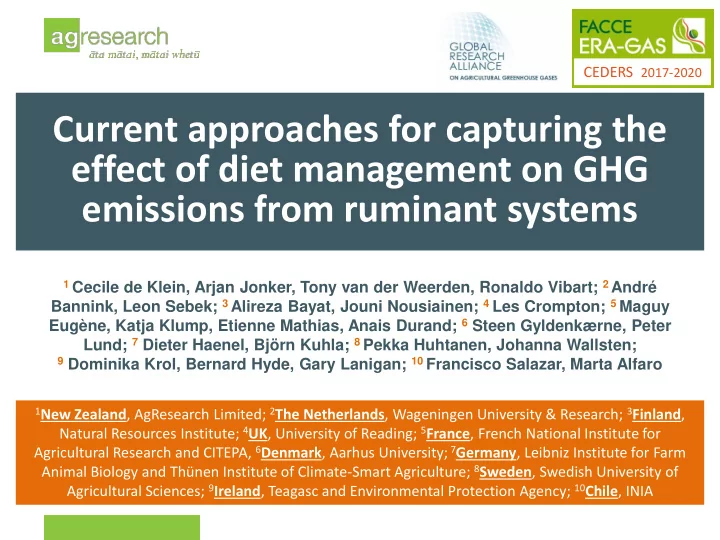

CEDERS 2017-2020 Current approaches for capturing the effect of diet management on GHG emissions from ruminant systems 1 Cecile de Klein, Arjan Jonker, Tony van der Weerden, Ronaldo Vibart; 2 André Bannink, Leon Sebek; 3 Alireza Bayat, Jouni Nousiainen; 4 Les Crompton; 5 Maguy Eugène, Katja Klump, Etienne Mathias, Anais Durand; 6 Steen Gyldenkærne, Peter Lund; 7 Dieter Haenel, Björn Kuhla; 8 Pekka Huhtanen, Johanna Wallsten; 9 Dominika Krol, Bernard Hyde, Gary Lanigan; 10 Francisco Salazar, Marta Alfaro 1 New Zealand , AgResearch Limited; 2 The Netherlands , Wageningen University & Research; 3 Finland , Natural Resources Institute; 4 UK , University of Reading; 5 France , French National Institute for Agricultural Research and CITEPA, 6 Denmark , Aarhus University; 7 Germany , Leibniz Institute for Farm Animal Biology and Thünen Institute of Climate-Smart Agriculture; 8 Sweden , Swedish University of Agricultural Sciences; 9 Ireland , Teagasc and Environmental Protection Agency; 10 Chile , INIA
CEDERS 2017-2020 Expected outcomes of work package 4 National GHG inventory models and on-farm accounting tools have been updated to better capture the effect of diet management on GHG emission from ruminant systems • Updated relationships between diet characteristics and GHGs • New approaches adopted (from other countries or other models) First step: understand how these models currently capture diet effects
CEDERS 2017-2020 Approach Review of inventory models from all partner countries Review of a range of on-farm accounting tools Key assessment criteria: • Activity data requirements (animal and feed characteristics) • How animal energy requirements and intake are assessed • How emissions from manure and excreta are calculated • Which diet characteristics are captured
Partner countries Finland CEDERS 2017-2020 Sweden Denmark Nether- Ireland lands UK Germany France Chile New Zealand
CEDERS 2017-2020 Results – Three generic approaches Three generic approaches for estimating methane and nitrous oxide emissions from livestock systems: 1. Per animal: • Methane emission factors per head of animal • Nitrous oxide emission factors per head of animal Feed characteristic captured: not applicable
CEDERS 2017-2020 2. Based on animal population characteristics and production: Estimates energy requirements, dry matter intake and N excretion • Methane emission per unit of dry matter intake • Nitrous oxide emission per unit of N excreted Key feed characteristic: energy and nitrogen contents of diet
EXAMPLE: New Zealand inventory model Milk and meat Animal population production characteristics CEDERS 2017-2020 (by animal class) (by animal class) Using methodology based on Australian feeding standard Metabolisable energy Metabolisable energy (ME) content in the diet (ME) requirements (MJ) MJ ME/kg DM (by animal class) Total dry matter intake Nitrogen (N) content CH 4 emission factor X X (by animal class) in dry matter (by animal class) Enteric CH 4 Total N intake emissions N in products (by animal class) Total N excretion Nin urine N 2 O emission Nin dung N 2 O emission Nin effluent N 2 O emission X X X /manure Factors effluent/manure factor urine factor dung Direct N 2 O emissions from animal excreta
CEDERS 2017-2020 Mechanistic approach to estimate net H + production 3. • Methane Rumen Methane out Excess H+ H+ H+ Feed in sources sinks • Nitrous oxide emissions generally estimated as approach 2, but feed digestibility is used for estimating N in urine and dung Feed characteristics: energy, sugar, starch, NDF, CP, NH 3 , fat, ash and nitrogen content and feed digestibility
Summary of Inventory approaches for enteric CH 4 CEDERS 2017-2020 Animal Animal production Mechanistic Country Population and population approach Chile Other livestock Cattle n/a Denmark Cattle n/a n/a Finland Other livestock Cattle, sheep and reindeer n/a France Other livestock Cattle n/a Germany Sheep, goats, horses Other cattle and swine Dairy cows Ireland Other livestock Cattle n/a Netherlands Sheep, goats All other cattle Lactating cows New Zealand Goats, swine, horses Cattle, Sheep, Deer n/a Sweden Other livestock Cattle n/a UK Other livestock Cattle, sheep n/a n/a = not applicable
CEDERS 2017-2020 On-farm accounting models – early results DairyWise RothC / RR FarmAC Landscape model SYKE Cool Farm Farm Carbon Farm Carbon Tool Footprint Calculator Calculator The Carbon Navigator BEEFGEM UP-Green-LCA OMINEA FASSET The CLA CALM Calculator
CEDERS 2017-2020 On-farm accounting models – early results Animal Animal production Mechanistic Country Population and population approach Denmark Fasset France FarmSIM Ireland C navigator BEEFGEM Netherlands Dairywise COWPOLL Farm C-footprint New Zealand Overseer Whole farm model calculator UK Cool farm tool SIMS dairy
CEDERS 2017-2020 In summary, Energy and N content and digestibility are the feed characteristics most commonly captured The more detailed approach captures additional feed characteristics e.g. sugar, starch, NDF, CP, NH3, fat and ash content Opportunities for improvement of models: - Moving towards more detailed approach - Better relationships between feed characteristics and CH 4 Results could help inform the data-base analysis
CEDERS 2017-2020 Acknowledgements This project is funded in the frame of the ERA-NET FACCE ERA-GAS. FACCE ERA-GAS has received funding from the European Union’s Horizon 2020 research and innovation programme under grant agreement No 696356. International funding bodies: Denmark: Innovationsfonden Finland: Ministry of Agriculture and Forestry France: Agence National de la Recherche Germany: Bundesministerium für Ernährung und Landwirtschaft Ireland: TEAGASC and Department of Agriculture, food and the Marine Netherlands: Nederlandse Organisatie voor Wetenschappelijk Onderzoek New Zealand: Ministry for Primary Industries (also supporting Chile) Sweden: Forskningsrådet för Miljö, Areella Näringar och Samhällsbyggande United Kingdom: The Secretary of State for Environment, Food and Rural Affairs
Recommend
More recommend